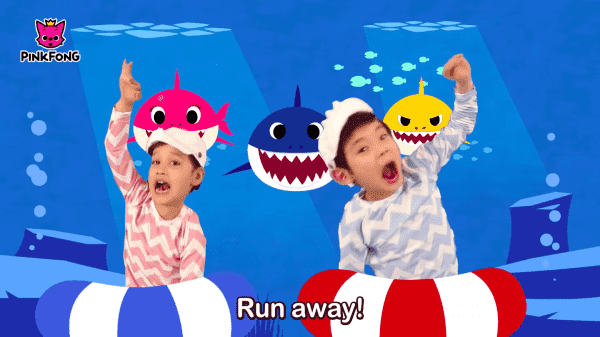
Whether or not you have children in your life, it may seem like the Baby Shark song is everywhere.
It’s an earworm. It’s a dance craze. It’s a meme.
And as of this week, it’s one of very few children’s songs in history to have landed on the Billboard Hot 100.
Not only did the infectious bop about a family of toothy fish make it onto the charts despite being not new in the slightest, it also scored the highest debut of the January 12 edition of the Hot 100, popping up at No. 32.
I guess you could say it made a splash. (Sorry.)
But how did we wind up here? How did this little ditty-that-could make the jump swim from toddler YouTube to the Billboard charts? Are you ready to see how a meme becomes a quiet cultural phenomenon? Then grab your fins and let’s go hunt (doo doo do doo do doo)!
“Baby Shark” is an addictive delight
If you’ve never heard of “Baby Shark” and have no idea what I’m talking about, you’re in for a treat, albeit an insanely addictive one. Be warned: The following tune will be stuck in your head for days, but I promise it’ll make you smile:
The “Baby Shark Dance” video above has been a global hit among the under-5 set — and, by extension, their parents — since it was first posted to YouTube in 2016, and it’s easy to see why. For one thing, the titular shark dance is appealingly simple, something even the youngest toddler and surliest adult can do.
It’s also visually enticing as well as ridiculously catchy: The video is well made, the kids are adorable, and the cheery, infectious song — doo doo do doo do doo! — meshes perfectly with the whimsical mix of animation and live action.
All of these factors have made “Baby Shark Dance” a bona fide YouTube hit. The video currently stands at nearly 2.2 billion views, making it one of the top 25 most-viewed videos in YouTube history.
“I know a lot of parents who use it as a bribe or a pacifying technique,” journalist, mom, and former Vox colleague Elisabeth Dickson told me. “It’s like toddler catnip. Bright, moving colors; cute little kids; catchy, repetitive lyrics. I would bet anything, though, that a lot of the views are repeat views from the same users.” While this is anecdotal evidence, it’s definitely true that there’s a lulling, hypnotic quality to looping the video; I’ve been known to listen to the 2-hour compilation version at times, and I’m still here to tell the tale.
What’s more, “Baby Shark Dance” fits in with a larger theme of wholesome internet trends, in that it’s simple and bright and turns sharks into cute and cuddly sea companions.
So it’s no wonder that Baby Shark has also become a wholesome internet meme, bringing together people all over the world to do the “Baby Shark Dance” and the “Baby Shark Challenge” (which are the same thing). In fact, as far as wholesome memes go, this is one of the wholesomest, in that it’s harmless and fun, and directly concerned with bringing people together instead of, say, being cynical or edgy, or snarking about the world. (At least if you discount the ecological havoc caused by allowing cute kids to ruthlessly invade the territory of these poor animated sharks, possibly putting everyone involved in danger.)
But memes rarely have a single source, and while there’s a single definitive version of the Baby Shark song that’s swum into the public consciousness, it has many predecessors.
Baby Shark’s history contains multitudes
The “Baby Shark” song itself seems to have no definitive origin point: Some versions of it are a longtime staple at youth summer camps and scouting retreats, and there are infinite variations on its basic premise, including one version where a surfer loses an arm and has to undergo CPR. Another version that dates to at least 2008 online includes the subject dying at the end.
“My husband and I sang it on a bus on the way back from a wedding and one of the people who was singing along knew the song from, like, camp,” Dickson told me. “She’d never even heard of [the famous internet version]. And I was like, ’What? How?’ because it’s such a cornerstone of my life now [that I have a kid].”
For the primogenitor “canonical” version of the internet-famous “Baby Shark Dance,” as it were, we can thank a fun-loving German woman named Alexandra Müller, a.k.a. Alemuel. On January 15, 2007, from the comfort of an armchair, she gave the world this viral video:
In German, this rhyme is a “singspiel” — a sung nursery rhyme — known as “Kleiner Hai” (Little Shark). So it was probably already known to most of Alemuel’s German viewers. But her video sparked a viral craze that ultimately spawned an official release of the song 15 months later, in May 2008, as well as, according to one German media outlet, around 400 spinoff videos of classrooms and other groups performing the accompanying dance.
And as you can see from the following 2012 version, the song and the dance have always pretty much existed as a pair — which makes sense, since a lot of the fun of Baby Shark lies in switching back and forth between little shark gestures and big shark gestures:
Fast forward to YouTube circa 2016, when international corporations (like the overwhelmingly popular Bollywood channel T-Series) were starting to slowly shift YouTube’s culture away from individual, grassroots vloggers and toward a mix of automated and mass-produced content.
These videos flooded YouTube’s algorithms and racked up billions of views, and children’s videos were — and continue to be — among the most popular examples. One reason that mass-produced kid’s videos have since become so successful is that their young target audience clearly finds their endless repetition appealing. Meanwhile, that same repetition makes them easy and cheap to produce, while still providing appeal and visual stimulation.
Among the most popular YouTube’s kid-centric mega-channels is Pinkfong. Overseen by a Korean education and entertainment company, Pinkfong has more than 14 million subscribers and has garnered more than 7 billion views across all of its videos. But more than 2 billion of those views come from “Baby Shark Dance.” Pinkfong uploaded the video on June 17, 2016, and although it obviously wasn’t the first variant of the Baby Shark song and dance on the internet, the video’s high production values, its cute kids, and its fun, colorful design set it apart and helped make it into a hit.
In the intervening years, Pinkfong itself has churned out a litany of Baby Shark offshoots; but its legs as a meme really come from what the rest of the internet has done with the song, with a push into the mainstream as an unexpected viral pop sensation.
After steadily building throughout 2018, the Baby Shark craze shows no real signs of stopping
Baby Shark’s first brush with all-ages, worldwide fame came in 2017, when it became massively popular in Indonesia. It spawned an Indonesian dance craze that saw families and communities around the country doing versions of the dance.
And in 2018, the #BabySharkChallenge became a huge meme across TikTok as the app burgeoned in popularity, with a popular remixed version of the song going viral.
This also meant that Pinkfong’s “Baby Shark” gained even more mainstream attention: It wasn’t just a song for kids anymore. In August 2018, it made its way onto the UK Top 40 charts, and in September, James Corden featured it on The Late Late Show. “Once in a lifetime, a song comes along that defines a generation,” he quipped.
By the end of October, the song had floated onto Billboard’s top streaming songs chart for the first time — at which point it had already spent more than six weeks atop Billboard’s Kid Digital chart.
In November, this was happening:
And in December, the song even made a cameo appearance in YouTube’s annual year-end Rewind video. (The 2018 edition of the video was historically disliked, but we won’t hold that against the sharks.)
All along the way, Pinkfong’s “Baby Shark Dance” video spawned offshoots in the form of flash mobs, covers, and, inevitably, many song variants. The most famous of these is perhaps the weird and eerie “Johny Johny Yes Papa” mashup meme that briefly took over the internet last summer, but one of the most recent popular riffs is a heavy metal edition by Norwegian guitarist Leo Moracchioli, who is known for his metal arrangements of pop songs:
So the Baby Shark song is clearly here to stay, having firmly established itself in many corners of the culture, online and off, in all its incessant repetitive glory. And yet, although it might seem to many like Baby Shark has reached a saturation point, a certain level of omnipresent universal existence, Dickson points out that in many respects, it’s still a niche.
“A lot of my friends without kids don’t even know what it is,” she told me.
If that’s the case, Baby Shark still has a lot of cultural permeation to do. So the next time you hear the song and you’re tempted to run away (doo doo do doo do doo), why not grab a friend instead, join in the dance, and help it along?
Sourse: vox.com






